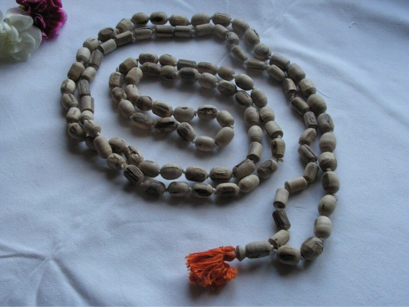by John Early
Contributing Author, Conscious Reminder
The mala necklace. That extra-long beaded accessory that has the look and feel of exotic beach vibes, yogi-surfer style, and mindful spirituality. But wait, what does it actually signify and why does it have 108 beads?
There has been a rise in people wearing mala necklaces in western culture. Just as practicing yoga has risen in popularity in the West these past few decades, so has the fashion statement of wearing a mala. The funny thing is, most people who wear them likely don’t know what it fully signifies, let alone have used it for its traditional use: counting mantras in meditation.
Where do Beaded Necklaces Come from?

Source: BohoChic.com
The trend of wearing malas might be ‘new’ to westerners but actually dates back thousands of years. The history of prayer beads is believed to have originated in India around the 8th century B.C.E. The majority of today’s religions also use beaded necklaces to help meditate and recite prayers (mala, Rosary, Subha, etc.). The English word bead even comes from the Anglo-Saxon words bede and bidden which mean ‘prayer’ and ‘to pray’. So there’s definitely nothing new about malas in the global world of fashion!
It’s good to note that you don’t have to be religious to wear or use a mala. It is important, though, to understand its use and respect its significance. The beads in a traditional mala are rudraksha seeds, produced by several species of large evergreen trees associated with the Hindu deity Shiva. In the yogic tradition, the beads are used in japa mala practice to recite mantras in meditation (hence the name). A full cycle of 108 repetitions is counted on the mala so the practitioner can focus on the sounds, vibration, and meaning of what is being said. A simple and common example of a Sanskrit mantra often chanted at the end of a yoga class would be om shanti shanti shanti, which is a calling out to connect us with inner peace.
The 109th bead that hangs at the bottom of a mala is called either the sumeru, bindu, stupa, or guru bead (which often symbolizes the guru from whom the student received the mala or mantra, paying homage to the student-guru relationship). It is never counted among the repetitions but is used as a marker for the start and end of a cycle.
The Best Explanations for Why a Mala Necklace Has 108 Beads

So why 108 repetitions? This is a question with hundreds of answers. The number 108 has limitless meanings across various philosophical, scientific, and religious beliefs. Some of the most intriguing are:
Sanskrit alphabet: There are 54 letters in the Sanskrit alphabet. Each has a masculine and feminine Shiva and Shakti. So, 54 times 2 is 108.
Heart Chakra: The chakras are the intersections of energy lines, and there are said to be a total of 108 energy lines converging to form the heart chakra. One of them, sushumna, leads to the crown chakra and is said to be the path to Self-realization.
Sun and Earth: The diameter of the Sun is 108 times the diameter of the Earth. The distance from the Sun to the Earth is 108 times the diameter of the Sun.
Moon and Earth: The average distance of the Moon from the Earth is 108 times the diameter of the Moon.
Planets and Houses: According to astrology, there are 12 houses and 9 planets. 12 times 9 equals 108.
Powers of 1, 2, and 3 in math: 1 to 1st power = 1; 2 to 2nd power = 4 (2×2); 3 to 3rd power = 27 (3x3x3). 1x4x27=108
Harshad number: 108 is a Harshad number, which is an integer divisible by the sum of its digits (Harshad is from Sanskrit and means “great joy”).
River Ganga: The sacred River Ganga spans a longitude of 12 degrees (79 to 91) and a latitude of 9 degrees (22 to 31). 12 times 9 equals 108.
1, 0, and 8: Some say that 1 stands for God or higher truth, 0 stands for emptiness or completeness in spiritual practice, and 8 stands for infinity or eternity.
Pranayama: If one is able to be relaxed in meditation as to have only 108 breaths in a day, enlightenment will come.
Now that you know your basic Mala 101 (er, Mala 108? ), hopefully you can find the time with your necklace to practice it’s formal use and have a deeper respect and understanding of why it’s worn. The Mala necklace is so much more than a new-age fashion statement.
Namaste amigos!
About the Author: John Early is an award-winning author, yogi, and co-founder of Momentom Collective – an international paradigm that fuses yoga, circus flow arts, and conscious community. Momentom offers retreats and residencies in Indonesia, Guatemala, Costa Rica and Panama.
If our work has made a positive impact on your life, we kindly ask for your support so we can continue our work. Thank you!
Now, you can follow Conscious Reminder on Facebook & Instagram!
∼If you like our article, give Conscious Reminder a thumbs up, and help us spread LOVE & LIGHT!∼
